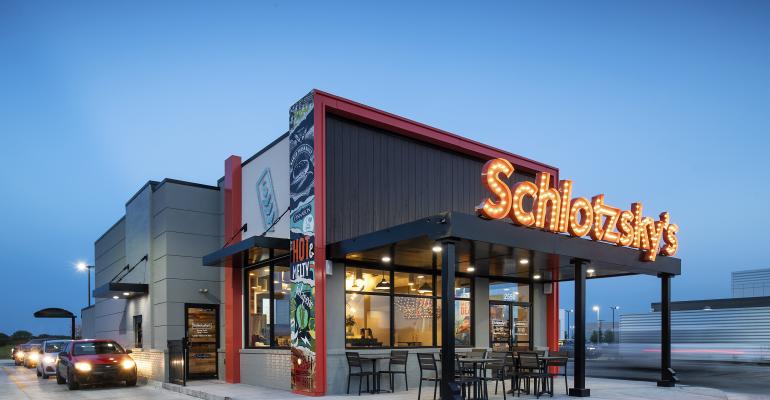From Taco Bell’s quadruple drive-thru to Panera’s dining room-free store, restaurants seem to be in a race to launch the smallest store prototype –and Schlotzsky’s is no exception. The Focus Brands-owned sandwich chain first announced two smaller units — an 1,800-square-foot and 1,000-square foot prototype — back in 2020, and just opened the first D-1,000 in Oklahoma City.
Like most restaurant chains, Schlotzsky’s investment in shrinking real estate is a direct response to changing customer demands, who want more off-premises convenience in a post-COVID world. Though Schlotzsky’s began the journey of downgrading store sizes in 2019 to combat rising real estate prices and focus on efficiency for franchisees, the pandemic was a push toward making that happen.
The smallest prototype features a double drive-thru: one on each side of the restaurant. One drive-thru is traditional and the other is specifically for first-and third-party delivery pickups. Even though these designs were meant to solve customer problems of ongoing demand for omnichannel access, they presented new challenges, Shelley Harris, chief brand officer with Schlotzsky’s told Nation’s Restaurant News.
“When you have two menu boards where you're taking orders at the same time, we really had to figure out how that flows through into our kitchen,” Harris said. “And when two menu boards are taking orders at the same time, we had to equip our drive-thru make station with a headset so that they could listen both to the first drive-thru lane and the second drive-thru lane, and start the production of those products before the guests finished ordering.”
Some of the logistical challenges the company has still not figured out quite yet, like POS integration with KDS for all of the orders and pickups coming in through various channels.
“We’re still looking at technology that can […] maximize throughput at those peak periods,” Harris said. “We built the first [1,000-square-foot design] knowing that we were going to have to go back and make some modifications as we continue to progress.”
For example, in the early days of launching this double drive-thru, Schlotzsky’s employees had to train customers that were going to the pickup lane because the service counter is now on the passenger side, which is not what customers are used to. The store needed to go back and modify signage and striping on the asphalt to make directional flow clear to customers and improve traffic confusion.
“The first couple of times, we had to have an employee out there asking customers if they are drive-thru or order-ahead and tell them where to go,” she added. “The customer response has been great so far […] but they are encouraging us to continue tweaking and modifying to create guest efficiency.”
Harris is confident that as more and more of these double drive-thru lanes with designated order-ahead pickup areas pop up, that the learning curve will flatten.
I feel like what we have equipped both our franchisees and our future with is just an array of designs that still deliver on the essence of what the shot sees experience is all about but allows that franchisee the flexibility to negotiate based on what their strategy is in building out their portfolio.
Moving forward, the company is also looking at more AI and automation in the drive-thru lane which could improve efficiency further.
“We have equipped our franchisees with an array of designs that still deliver on the essence of what the Schlotzsky’s experience is all about, but allows that franchisee the flexibility to negotiate based on what their strategy is in building out their portfolio,” Harris said.
Contact Joanna Fantozzi at [email protected]
Follow her on Twitter: @JoannaFantozzi





